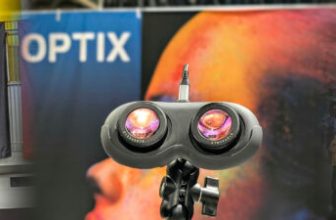
Swave Photonics, a provider of holographic display technology, has today demonstrated a prototype of its first true color 3D holographic display technology using phase change materials.
Using chip-based “Holographic eXtended Reality” (HXR) technology, the prototype from Swave uses what the company stated is “the world’s smallest pixel” to steer light and sculpt high-resolution images for full spatial color.
Can you explain the concept of “phase change materials”?
Phase change materials are substances that can change their physical state (like from solid to liquid) when heated or cooled. When it comes to display technology, they are used to control light at a very small scale. This helps create the tiny pixels that make up the high-resolution images.
Spatial color versus current color displays
Swave claimed that utilizing a spatial color technique enables the human eye to perceive images in a natural manner and is more easily processed by the brain. The company achieves complete spatial color by arranging color filters in a specific pattern on a single panel, which is divided into subpixel color regions. The benefits of full spatial color encompass diminished visual imperfections, extended battery lifespan, and an enhanced visual experience due to the elimination of eye movement distortions and the optimization of static image quality.
Swave states that conventional displays either utilize three distinct panels for each primary color (red, green, and blue), or rapidly alternate these colors to generate complete color imagery. Swave notes that these approaches can be cumbersome, costly, or demanding in terms of power.
“Swave’s early stage prototype holographic images were monochrome, allowing us to demonstrate proof of concept on this breakthrough technology,” said Mike Noonen, CEO of Swave. “The next step of developing HXR in full color is extremely challenging. Many technologies trick the human brain to form colors by rapidly sequencing different colors. Achieving simultaneous color brings us one step closer to recognizing the vision of reality-first augmented reality (AR) informed by AI in a compact form factor.”
Color HXR for compact smart glasses
The initial use intended for the color HXR display technology by Swave is in the form of energy-efficient and lightweight smart glasses. This spatial color feature proves beneficial for both indoor and outdoor use, making it perfect for everyday wear.
Edward Buckley, vice president of AR solutions at Swave, stated that Swave is transforming the display of colors and how they are perceived. He explained that by utilizing a spatial color method, Swave is pioneering a new way to achieve AR technology that can be worn all day and is accessible to consumers. Swave’s holographic AR display is unique in its ability to align with human vision and perception, resulting in a more comfortable experience for users. Additionally, this display offers advantages in terms of size, cost, and power consumption.
To learn more about Swave Photonics and their Holographic eXtended Reality (HXR) display technology, please visit the company’s website.







